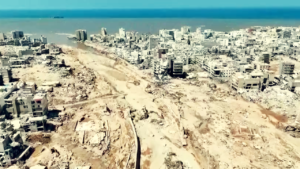Physical Address
23,24,25 & 26, 2nd Floor, Software Technology Park India, Opp: Garware Stadium,MIDC, Chikalthana, Aurangabad, Maharashtra – 431001 India
Physical Address
23,24,25 & 26, 2nd Floor, Software Technology Park India, Opp: Garware Stadium,MIDC, Chikalthana, Aurangabad, Maharashtra – 431001 India

The devastating floods that began in Libya on September 11 have claimed the lives of at least 3958 people, according to official UN figures. But with over 9000 still missing, the death toll might increase.
On September 10, wind speeds reached as high as 70-80 km/h in northeastern Libya after Storm Daniel struck the region, leading to record rainfall. The situation worsened after two aging dams in the city of Derna in Libya collapsed and washed away homes and access roads.
The immediate cause was extreme rainfall
The equivalent of a year’s rainfall occurred within 24 hours in Libya. The World Meteorological Organization (WMO) stated that multiple areas in Libya received 150-240 mm of rain and the town of Al-Bayda received 414.1 mm of precipitation in 24 hours. Derna city gets 274 mm of rainfall in an average year.
Experts are saying that the unusually severe nature of the rainfall that led to the flood was the likely impact of climate change after it amplified Storm Daniel (a low-pressure weather system that developed over the Mediterranean Sea around September 4, 2023). It resulted in unprecedented rainfall in Greece on September 5 and 6, 2023. The Greek village of Zagora recorded 750 millimeters of rain in just 24 hours, which is equivalent to approximately 18 months’ worth of rainfall.
Subsequently, the storm intensified further over the sea, transforming into a “Medicane” – a Mediterranean storm displaying hurricane-like characteristics. It eventually made landfall in Libya on September 10.
Dr. Liz Stephens, an associate professor in climate risks and resilience at the University of Reading, said, “Climate change is thought to be increasing the intensity of the strongest medicanes and we are confident that climate change is supercharging the rainfall associated with such storms.”
Nature quoted geoscientist Jasper Knight at the University of the Witwatersrand in Johannesburg, South Africa, admitting that the rainfall and flooding have been unprecedented in Libya. With the Mediterranean Sea being the primary source of weather for Libya, the Mediterranean coast is relatively green, but such heavy rainfall has yet to be witnessed in decades, he was further quoted as saying.
The Nature article further quoted Günter Blöschl, a hydrologist at the Vienna University of Technology, as saying that there is a clear causal link that can be said even without a detailed analysis at this point in time.
The same article quoted Hayley Fowler, who studies climate-change impacts at Newcastle University, UK, as saying that the intensification comes from the increase in sea surface temperatures as increased sea surface temperatures injected moisture into Storm Daniel, leading to an escalation in the winds and rainfall.
The Nature article also quoted Álvaro Pimpão Silva, a WMO climate specialist, as saying that although the sea surface temperatures were not very high, it was above 26 °C, which was enough to fuel storms.
Warming exposes other vulnerabilities
IPCC’s sixth comprehensive report on climate change revealed that from 2010 to 2020, the loss of human lives due to floods, droughts, and storms was 15 times higher in regions that are particularly susceptible, characterized by weak governance and fragile infrastructure. Furthermore, the report expressed a substantial degree of confidence in its prediction that these risks will escalate as global temperatures continue to rise.
Libya seems to have become the perfect case study for the same. The political and socio-economic condition in Libya has dramatically contributed to the severity of the disaster. The deposition of Libya’s military leader, Muammar Gaddafi, in 2011 led to the country getting engulfed in a civil war apart from being subjected to international sanctions.
This has led to Libya’s poor infrastructure, the vulnerability of which got exposed during extreme weather situations such as this, creating devastation. The dams of Derna were aging and lacked maintenance, and it extends to problems related to social infrastructure as well with the lack of an adequate flood warning and defense system.
References:
https://groundreport.in/shocking-three-years-worth-of-rain-fell-within-two-days-in-greece/
https://www.reading.ac.uk/news/2023/Expert-Comment/Storm-Daniel-and-floods-in-Libya
https://reliefweb.int/report/libya/wfp-libya-floods-response-external-situation-report-1-17-september-2023#:~:text=Two%20ageing%20dams%20burst%20in,3%2C950%20registered%20deaths%20in%20hospitals.